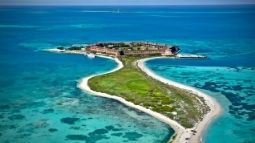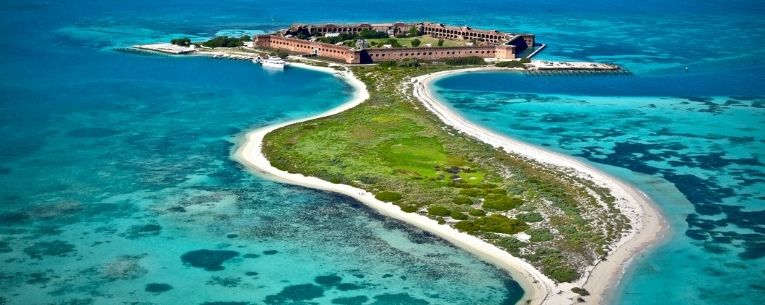U.S. National Parks are becoming more popular than a window seat on a Trans-Atlantic flight.
In 2019 alone, the parks notched more than 320 million visits.
In the pandemic-slowed year of 2020 — even with all the closures and capacity constraints — about 240 million still made it through the gates.
But this popularity is pretty top-heavy, with half of all visits occurring among just 6% of the parks — including Smoky Mountains National Park (12 million annual visits) and Yellowstone (4 million).1
It begs the question: why aren’t the other parks drawing a crowd?
Oftentimes, it has to do with accessibility. For example, 5 of Alaska’s 8 National Parks aren’t reachable by road.2 Other times, the parks are newer to the system and simply lack name recognition, such as California’s Pinnacles National Park, which we’ll explore below.
But all in all, these parks can spark just as much adventure and joy as their much more popular neighbors.
In this article, you’ll learn about some of the underappreciated destinations in the U.S. National Park System, where there probably won’t be traffic coming through the gates and you’ll definitely find more wildlife than people.
Why Travel Insurance Is Important for U.S. National Park Getaways
National Parks aren’t exactly unexplored wilderness. They have rangers, some basic infrastructure, safety rules, and even other visitors.
But it’s still the wild. And when you’re trekking to one of the less-visited parks, you don’t always have the comfort of safety in numbers.
So, when you’re packing the pop-up tent and six-pack of buffalo repellent, be sure to include a travel insurance plan, too. The right plan from Allianz Partners can help you with a number of potential scenarios, whether you need to cancel at the last minute because of a family emergency, you’re looking to rent a 4WD vehicle for the road trip out to the park, or a bear steals your wallet sometime during the night (or maybe you left it in the kayak —yeah, that’s probably it). Just review your specific plan to make sure your circumstances match up with the plan’s covered reasons.
Allianz Partners has been equipping National Park campers and visitors with travel insurance plans for years. And we’re confident we have a plan that fits your next outdoor adventure.
Get Way Away at Dry Tortugas National Park
When you wrap up the picturesque drive down Route 1 south of Miami, Key West is a paradise that feels miles away from other vacation hotspots.
Cruise just 70 miles west to Dry Tortugas National Park, and you’ll land in what looks like another world.
Here nearly every type of turtle under the sun finds a home — hence the name coined by Ponce de Leon when he discovered the seven islets comprising Las Tortugas (translated: The Turtles).3
Tortugas is more than a paradise for shelled slowpokes. It also calls out to Scuba divers and snorkelers with plentiful coral reefs, exotic fish finds, and vast shipwrecks. The park is also popular with military history buffs. Fort Jefferson, a sprawling and strategically located perch was constructed — but never completely finished — in the mid-1800s.
Of course, the most inviting far corners of the country are often the hardest to reach. Dry Tortugas is only accessible by seaplane, ferry, or private watercraft with the proper permit.
Know before you go: April through November is the ideal time to make the Dry Tortugas trek. Campsites are limited. And be sure not to touch the coral reefs — or the turtles.4
Experience Downhill Thrills at Great Sand Dunes National Park
There are a handful of destinations across the country that, if you play your cards right, you can hit the slopes and hit the beach in the same day.
At Great Sand Dunes National Park in southern Colorado, you can experience the best of both worlds without ever leaving.
The parks boast 30 square miles of sandy slopes — one measuring in at 750 feet high — that earns them the title of tallest sand dunes in North America. And these dunes aren’t just fun to marvel at and photograph. They’re a blast to ride down, too.5
Great Sand Dunes National Park is the capital of sand sledding and sandboarding. The rules are pretty easy: buy or rent a sled or board at a neighboring store (no, you can’t use a traditional snow sled or snowboard here), pick anywhere in the dune field away from vegetation, and enjoy the ride. Don’t worry, there are tame dunes for beginners and children. And while the park is open 24/7, 365 days a year, early morning and evening is the wisest time to hit the dunes. That’s because on hot summer days, surface temperatures can reach 150F.
While the sand dunes are the featured attraction of the aptly named park, there’s plenty of other sights to see. Take Medano Creek, a natural waterpark in the spring that disappears as the summer wears on. Its welcoming, shallow waters are an ideal spot to float or paddle around with the kids, cooling off after a day chasing the perfect ride on the dunes. You can also skimboard, create sand sculptures — and if the water is deep enough — blow up a raft to float around.6, 3
Be Free as a Bird at Pinnacles National Park
U.S. National Parks aren’t a static set of destinations that stay the same year in and year out.
Take Pinnacles National Park, located beside California’s Salinas Valley 80 miles south of San Jose, which was just added to the park roster in 2013.7
Pinnacles has the look and feel of a park that’s still being discovered. With just around 165,000 annual visitors, its crowds dwarf that of other parks. And one of the positive upshots of the relative sparse visitors is that the wildlife goes on as it would if humans weren’t even there.8
This is huge for the birding crowd. Pinnacles features nearly 200 different species of birds, with the California condor and its 9-foot wingspan as the featured attraction. You’ll also find peregrine falcons and golden eagles. But don’t keep your eyes solely set on the skies. Pinnacles National Park features an amazing comeback story: the California Red-Legged Frog. While listed as a Threatened Species, these amphibians are proliferating once again thanks to a painstaking repopulation project conducted by the park.9 You can identify the California Red-Legged Frog in the park’s Bear Gulch Reservoir area by the trademark reddish coloring on its underbelly and legs.10 But don’t get too close. It’s illegal to harass the Endangered Species; even approaching so close as to cause them to jump is a no-no.
Also take time to admire the Pinnacles terrain, formed from the lava flow of surrounding volcanoes some 23 million years ago. Explore 30 miles of hiking trails across canyons and woodlands, making your way around the domed rock formations that are the namesake of Pinnacles National Park. And be sure to visit one of the park’s most popular attractions: two talus caves. Bear Gulch Cave and Balconies Cave were created when pile-ups of large round rocks formed passages big enough for visitors to explore.9 Just be sure to check their status before you set out to explore among the bats and boulders.11
Seeing the most popular U.S. National Parks also means seeing lots and lots of other travelers. By staying off the beaten path and visiting these under-the-radar national parks, you’ll experience the Great Outdoors without having to wait in line.
Related Articles








Share this Page